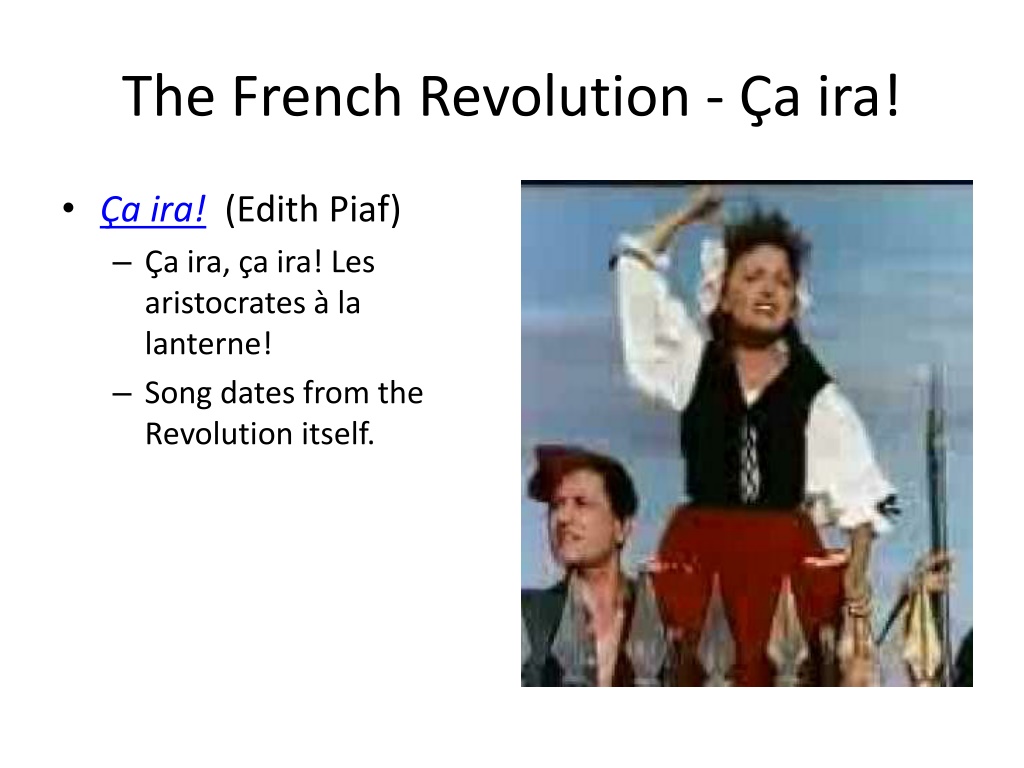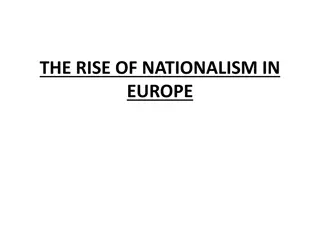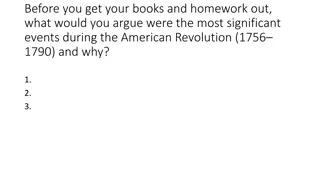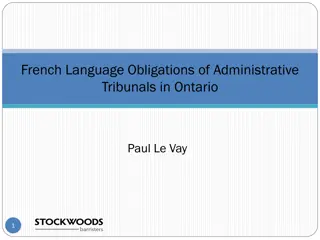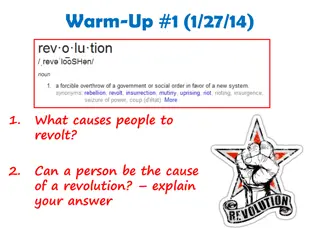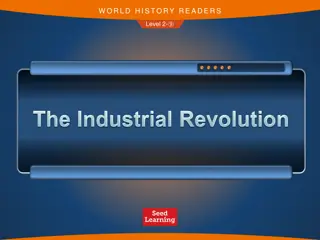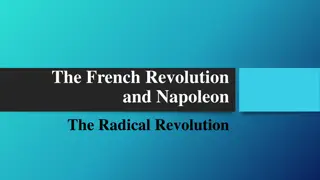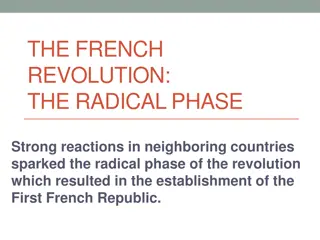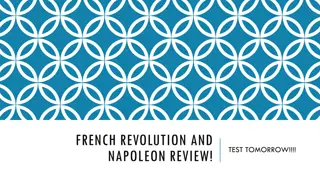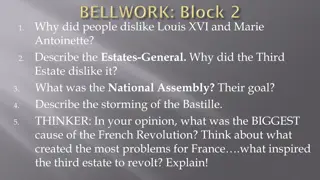The French Revolution: A Catalyst for Modern Transformation
The French Revolution, a historical turning point, challenged traditional authority structures and introduced ideologies like liberalism, republicanism, and socialism. This era of societal upheaval posed questions about the nature of power and governance, leaving a complex legacy that continues to influence debates on human rights and democracy.
Download Presentation

Please find below an Image/Link to download the presentation.
The content on the website is provided AS IS for your information and personal use only. It may not be sold, licensed, or shared on other websites without obtaining consent from the author. Download presentation by click this link. If you encounter any issues during the download, it is possible that the publisher has removed the file from their server.
E N D
Presentation Transcript
The French Revolution - a ira! a ira! (Edith Piaf) a ira, a ira! Les aristocrates la lanterne! Song dates from the Revolution itself.
Making of the Modern World The French Revolution
The French Revolution It was the best of times, it was the worst of times. - Charles Dickens, A Tale of Two Cities The French Revolution is a movement of God. It is a pure gift to progress. - Victor Hugo, Les Mis rables
Enduring Reference Point for Social and Political Change It will be like the French Revolution It will take years. Hatim Tallima of the Revolutionary Socialists in Cairo, 2013 (Arab Spring)
Watershed moment of modernity Overturned Divine-right, absolutist monarchy Privilege (as opposed to equality before the law) Nobility Guilds, corporations The Church s wealth and moral preeminence
Inaugurated (sometimes in proto form): Liberalism Republicanism Socialism Conservatism Free-market capitalism Feminism Nationalism Imperialism (an ideologically driven form of it) Liberal authoritarianism (contradiction in terms?) Totalitarianism (Cold War term: from Rousseau, to Robespierre, to Stalin?) Secular universalism
Burke (anti) vs. Paine (pro) Kings will be tyrants by policy when subjects are rebels by principle. Burke, Reflections on the Revolution in France (1790) The circumstances of the world are continually changing and the opinions of man also; and as government is for the living, and not for the dead, it is the living only that has any right in it. Paine, Rights of Man (1791)
Historical debates Origins Circumstances (financial, political) Class Enlightenment ideas Public Opinion Course Was radicalisation inevitable? Why the Terror (1793-94, the Year II)? Why did republicanism give way to authoritarianism? Legacies Did the French Revolution pave the way to liberalism and human rights, social democracy or pathological forms of democracy?
Thesis of circumstances Financial breakdown France helped finance the American War for Independence from Britain (1770s-1780s) More than half of annual tax revenues used up to pay interest on the debt (1786) No central bank, regime borrowed at high interest rates Refusal to pay more taxes Political juggernaut Parlements and Notables (represent the nation ) vs. Monarchy Bad harvests, high bread prices
Class Thesis (prevalent in mid-20th century) Three Estates Clergy, nobles, third estate High bourgeoisie: had most of the productive power but no political power abb Siey s, What is the Third Estate? (1789) What is the Third Estate? Everything What has it been recognised to be until now? Nothing What does it aspire to be? Something
Enlightenment Origins: Ideas? Faute Rousseau? Collective sovereignty Moral regeneration and virtue Utopian principles lead to authoritarianism? Faute Voltaire and aux philosophes? Desacralisation of throne and altar Critical reason trumps ethics, morality
Enlightenment Origins: Public Opinion A more literate and critical public Content of print and conversations Critical of monarchy (debauched, arbitrary, corrupt) Irreverence for sacred power: throne and altar The rise of a critical public, thinking for oneself People, bombarded with print (some of it produced by politically interested sources like the monarchy) learn to be skeptical
Course of Revolution Liberal Phase 1789-1792 (constitutional monarchy) Radical Phase 1792-1794 (republic) Year II, the Terror (1793-94) Thermidor 1794-1795 (republic) Directory 1795-1799 (republic, but increasingly authoritarian) Consulate, Empire 1799-1814 (Napoleon)
Meeting of the Estates General May 1789 Prior failure to persuade hand-picked assemblies of notables (1787 and 1788) to agree to more taxes Parlement (sovereign judicial courts) refuses to agree to more taxes Only remaining solution is an Estates General: a meeting of the clergy, nobles and third estate. First time since 1614 (absolutism had suppressed most representative bodies).
1789 La Rvolution June 17 - Third Estate, impatient and suspicious of clergy and nobles, declares itself to be the nation . Asserts its sovereign authority over taxation and swears to uphold the debt Also creates a committee to investigate bread crisis and propose solutions. Late June Louis XVI eventually concedes but plots military repression.
June 20 Tennis Court Oath (indoor, see below) New National Assembly takes an oath to refuse to disband until Constitution is completed June 27 Louis XVI concedes but plots military repression
1789 July 14 The Storming of the Bastille Parisians, in search of arms to protect themselves from monarchy s repression, attack this fortress and prison on the edge of Paris for arms; few prisoners being held there at the time. Governor fires on crowds, who storm the prison and put his head on a pike. August 4 Abolition of Privilege (end of the Old Regime, since privilege was at the very heart of it) End of August: Declaration of the Rights of Man and of the Citizen October 5-6 Women s Bread March to Versailles Brings King, Queen and National Assembly to Paris, where they were more vulnerable to popular pressures
Storming of the Bastille, July 14 Was torn down, stone by stone
Declaration of the Rights of Man and of the Citizen note resemblance to Ten Commandments: a modern, secular religion?
1790 Civil Constitution of the Clergy State seizes church lands (10-12% of all land), which will be auctioned off (to pay for the national debt) Closure of monasteries and convents (seen as un-useful institutions in an age of Enlightenment utility) Requires religious clerics to swear an oath to uphold the new Constitution Left/Right splits in National Assembly Arch-Royalists sit on right; Progressives (Jacobins and their allies) on the left Spread of Jacobin clubs throughout France Who were Jacobins? Initially a group of legislators who met to strategize Eventually, became a nationwide network of clubs in favour of a constitution, rights and legal equality Often pressured local officials to carry out new laws
1791 June: Flight of the King to Varennes Intended to return with counterrevolutionary troops to put down the Revolution (Marie- Antoinette s brother, Joseph, was emperor of the Habsburg Empire) Louis XVI was recognized at border by a postman, sent back to Paris July: Radicals call for a Republic authorities fire on them: Massacre on the Champs de Mars
1791 Constitution (September) Legislative Assembly replaces Constituent Assembly Abolition of guilds, corporations and all government regulation bodies
1792 Tensions increase Religious Counterrevolutionary propaganda proliferates Resistance to clerical oath and anger about new constitutional priests imposed on parishes -- Social and economic Disruptions in the world of labour; popular discontent infiltrates political clubs and sections -- Political King is essentially a prisoner in Paris, plotting in hopes of a foreign invasion to put down revolution Divisions among revolutionaries radicals vs. moderates (Jacobins / Girondins)
1792 April: War declared against Austria. Soon, France is at war with most of its neighbours, who fear the spread of revolution. August 10: The monarchy falls in violent insurrection September 2-7: Prison massacres of priests and nobles in Paris by radical sans-culotte forces September 21: First Republic declared Constitution won t be promulgated until June of 1793 Operating in a state of exception all executive decisions easily denounced as arbitrary no constitutional guidelines.. Sharp tensions between a free-market and regulated economy Pressure for political justice
1793 January 21: Louis XVI is guillotined March: counterrevolutionary revolts in Vend e Terror gears up Creation of the Committee of Public Safety (executive) Committee of General Security (police committee) Revolutionary Tribunals (which condemn enemies of the revolution to the guillotine June: Jacobins, pushed by sans-culottes in Paris, purge the Girondins from National Convention. Summer: Federalist Revolts against Paris and sans-culotte movement (provinces resent purge) Autumn: Marie-Antoinette and Girondins guillotined
1794 Slavery in French colonies abolished (Feb) Terror escalates (spring) Purge of Dantonistes (who wanted to end the Terror) Purge of H bertistes (sans-culottes who wanted to push the Terror further) High Terror (June/July): thousands executed in Paris 27 July (9 Thermidor): Robespierre and other members of the Committee of Public Safety are arrested and guillotined
1795-1799 The Directory Executive-heavy Republic, with 5 directors Difficult to pursue a middle path between radicalism and royalism 1797: elections are nullified; repression increases Revolution exported; the republican generals gain in reputation and power 18 Brumaire (Nov 9, 1799): Coup brings Napoleon to power
1800-1815 Consulate and First Empire: Napoleon conquers much of Europe overturns old regimes across Europe Fleeces conquered countries but imposes new ideology and administrative structures creating new political and administrative structures that will help bring about the rise of nation states across the 19th century
Key terms and concepts Declaration of the Rights of Man and of the Citizen (1789) Jacobinism (centralising state, fiercely secular, touch of social justice) Sans-culottes (for economic regulations and punishment of enemies of the nation) Vend e (civil war) Lev e en masse universal draft, largest army in Europe almost overnight (1793---) Terror Guillotine (pain and torture is no longer the point of judicial punishment. Equality and prompt, painless elimination of enemies from the nation)
The Terror in perspective Struck at all suspects of the new regime. Deaths from revolutionary strife 17,000 executions by revolutionary tribunals 15,000-17,000 die in prison Deaths in civil and foreign wars (1792-1815) roughly 4 million across Europe 250,000 to 400,000 in the civil war of the Vend e Most deaths occur during Napoleon s wars
A new culture Time, weights and measure - rationality Metric system created more rational than inches, feet, etc. Revolutionary Calendar based on nature. 10 day weeks Brumaire (Nov-Dec): brume means fog Vent se (March-Apr): vent means wind Revolutionary Festivals Festival of the Supreme Being (June 1794) Deism Notre Dame cathedral converted into the Temple of Reason Some public schools and museums founded Cult of the Nation Pantheon: where France s great heroes were buried Voltaire, Rousseau, radical murdered journalist Marat, etc.
Sample of a meter for public to use as guide, during Revolution
A Temple of Reason (conversion of church, 1794) Reads: The French people recognise the Supreme Being and the immortality of the spirit
Guillotine Execution of Louis XVI (Jan 21, 1793)
Impact Revolutionary persists across (19th Century) Notably in 1830, 1848 and 1871 Nationalism, rise of nation states (19th/20th centuries) Democratic revolutions across the world (20th century) Literature and Philosophy Fires imaginations for more than two centuries
Founding Interpretations Edmund Burke (Reflections on the Revolution in France, 1790) Modern conservatism Need for tradition and reverence Alexis de Tocqueville (The Old Regime and the French Revolution, 1857) Abstract literary politics (Enlightenment) combines with state centralisation to form new, modern forms of political oppression Marx/Jaur s (mid 19th, turn-of-20th) Revolution as class war
Confused? Click here or https://www.youtube.com/watch?v=wXsZbkt 0yqo
